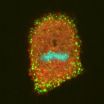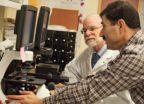(Press-News.org) Researchers from Warwick Medical School have discovered the key role of a protein in shutting down endocytosis during mitosis, answering a question that has evaded scientists for half a century.
The study, published today in the journal eLife, is the first to outline the role of actin, a protein, in shutting down clathrin-dependent endocytosis during mitosis.
Endocytosis is the process by which cells absorb molecules that are too large to pass through the plasma membrane, such as proteins. Clathrin-dependent endocytosis is the most common route for this. Clathrin, a protein, forms a pit on the inner surface of the membrane which allows the cell to engulf and bring in a small volume of fluid from outside the cell.
The team, led by Dr Steve Royle, were able to answer a question that was first asked in 1965 by American cell biologist, Don Fawcett. Fawcett became aware that clathrin-dependent endocytosis shuts down during mitosis, but the understanding of why it happens has eluded researchers until now.
In the latter part of the 20th Century, two competing theories emerged. One theory suggested that the tension of the plasma membrane is too high for endocytosis to occur. The other theory stated that the cell actually switches off the proteins involved by a process of mitotic phosphorylation, the addition of a phosphate group to the cell proteins.
More recently, scientists found that in non-dividing cells, when membrane tension is high, endocytosis can still occur because actin can be recruited to help clathrin to overcome the high tension in the membrane.
The Warwick team measured membrane tension in mitotic cells and found it to be much higher than in non-dividing cells, thus sparking the investigation into why actin is not recruited to help out in this case. They found that during mitosis, actin is busy forming a stiff cortex in the cells and so cannot be used to help out endocytosis. In other words, actin is needed, but is unavailable for use.
By tricking the cell into making actin available during mitosis, the researchers were able to restart endocytosis in mitotic cells. The paper also describes how mitotic phosphorylation does not inhibit the process, arguing against the alternative theory.
The newfound appreciation for the role played by actin opens the door for further developments, both for researchers and for possible clinical applications.
Dr Royle explained, "The implications for human health are truly fascinating; by knowing the role played by actin we can look to use it to restart endocytosis during cell division. That could mean that we're able to make dividing cells receptive to pharmaceuticals or other medical treatments in a way that we haven't before."
"It also opens up other strands of research and questions for our field. For instance, how does the cell know that the membrane tension is too high for normal endocytosis? When and how does it call in actin? There is plenty we are yet to discover."
INFORMATION:
The research was funded by the Biotechnology and Biological Sciences Research Council (BBSRC).
Mitosis mystery solved as role of key protein is confirmed
2014-02-18
ELSE PRESS RELEASES FROM THIS DATE:
Learning to see better in life and baseball
2014-02-17
With a little practice on a computer or iPad—25 minutes a day, 4 days a week, for 2 months—our brains can learn to see better, according to a study of University of California, Riverside baseball players reported in the Cell Press journal Current Biology on February 17. The new evidence also shows that a visual training program can sometimes make the difference between winning and losing.
The study is the first, as far as the researchers know, to show that perceptual learning can produce improvements in vision in normally seeing individuals.
"The demonstration that ...
Outsmarting nature during disasters
2014-02-17
The dramatic images of natural disasters in recent years, including hurricanes Katrina and Sandy and the Tohoku, Japan, earthquake and tsunami, show that nature, not the people preparing for hazards, often wins the high-stakes game of chance.
"We're playing a high-stakes game against nature without thinking about what we're doing," geophysicist Seth Stein of Northwestern University said. "We're mostly winging it instead of carefully thinking through the costs and benefits of different strategies. Sometimes we overprepare, and sometimes we underprepare."
Stein will ...
Zoonotic diseases and global viral pandemics
2014-02-17
Emergence of new microbes
While many endemic infectious diseases of humans have been largely contained, new microbes continue to emerge to threaten human and animal health. Such emerging infectious diseases are not confined to humans and their livestock but extend to wildlife ecosystems; the finely-tuned dynamic balance of which is destabilised by human interventions. The changes in the scale and manner of livestock production and marketing, the increase of global travel and trade including the trade in domestic livestock as well as the pet animal trade, the increasing ...
JCI early table of contents for Feb. 17, 2014
2014-02-17
Neurotensin conjugate provides pain relief in animal models
The small peptide neurotensin is a potent regulator of dopamine signaling and can provide dramatic pain relief; however, the blood brain barrier provides a substantial challenge toward clinical use of neurotensin for analgesia. In this issue of the Journal of Clinical Investigation, Philippe Sarret and colleagues at Université de Sherbrooke generated a conjugate of neurotensin with a peptide able to cross the blood brain barrier and evaluated the analgesic effects of this molecule in animal models of pain. The ...
Extensive renewal of the T cell repertoire following autologous stem cell transplant in MS
2014-02-17
WA, Seattle (February 17, 2014) – A new study describes the complexity of the new T cell repertoire following immune-depleting therapy to treat multiple sclerosis, improving our understanding of immune tolerance and clinical outcomes.
In the Immune Tolerance Network's (ITN) HALT-MS study, 24 patients with relapsing, remitting multiple sclerosis received high-dose immunosuppression followed by a transplant of their own stem cells, called an autologous stem cell transplant, to potentially reprogram the immune system so that it stops attacking the brain and spinal cord. ...
Finding common ground fosters understanding of climate change
2014-02-17
EAST LANSING, Mich. — Grasping the concept of climate change and its impact on the environment can be difficult. Establishing common ground and using models, however, can break down barriers and present the concept in an easily understood manner.
In a presentation at this year's meeting of the American Association for the Advancement of Science, Michigan State University systems ecologist and modeler Laura Schmitt-Olabisi shows how system dynamics models effectively communicate the challenges and implications of climate change.
"In order to face the ongoing challenges ...
Small non-coding RNAs could be warning signs of cancer
2014-02-17
Small non-coding RNAs can be used to predict if individuals have breast cancer conclude researchers who contribute to The Cancer Genome Atlas project. The results, which are published in EMBO reports, indicate that differences in the levels of specific types of non-coding RNAs can be used to distinguish between cancerous and non-cancerous tissues. These RNAs can also be used to classify cancer patients into subgroups of individuals that have different survival outcomes.
Small non-coding RNAs are RNA molecules that do not give rise to proteins but which may have other ...
New finding points to potential options for attacking stem cells in triple-negative breast cancer
2014-02-17
ANN ARBOR, Mich. — New research from the University of Michigan Comprehensive Cancer Center and Georgia Regents University finds that a protein that fuels an inflammatory pathway does not turn off in breast cancer, resulting in an increase in cancer stem cells. This provides a potential target for treating triple negative breast cancer, the most aggressive form of the disease.
The researchers identified a protein, SOCS3, that is highly expressed in normal cells but undetectable in triple-negative breast cancer. They showed that this protein is degraded in cancers, blocking ...
Religious and scientific communities may be less combative than commonly portrayed
2014-02-17
One of the largest surveys of American views on religion and science suggests that the religious and scientific communities may be less combative than is commonly portrayed in the media and in politics.
Only 27 percent of those surveyed said that they viewed science and religion as being in conflict with each other, with about equal percentages of those people "siding with either religion or science," said Rice University sociologist Elaine Howard Ecklund at the AAAS Annual Meeting. The survey was commissioned by the AAAS Dialogue on Science, Ethics and Religion (DoSER) ...
Uncovering the secrets of tularemia, the 'rabbit fever'
2014-02-17
WASHINGTON D.C. Feb. 16, 2014 -- Tularemia, aka "rabbit fever," is endemic in the northeastern United States, and is considered to be a significant risk to biosecurity -- much like anthrax or smallpox -- because it has already been weaponized in various regions of the world.
At the 58th Annual Biophysical Society Meeting, which takes place Feb. 15-19, 2014, in San Francisco, Calif., Geoffrey K. Feld, a Postdoctoral researcher in the Physical & Life Sciences Directorate at Lawrence Livermore National Laboratory (LLNL), will describe his work to uncover the secrets of the ...


